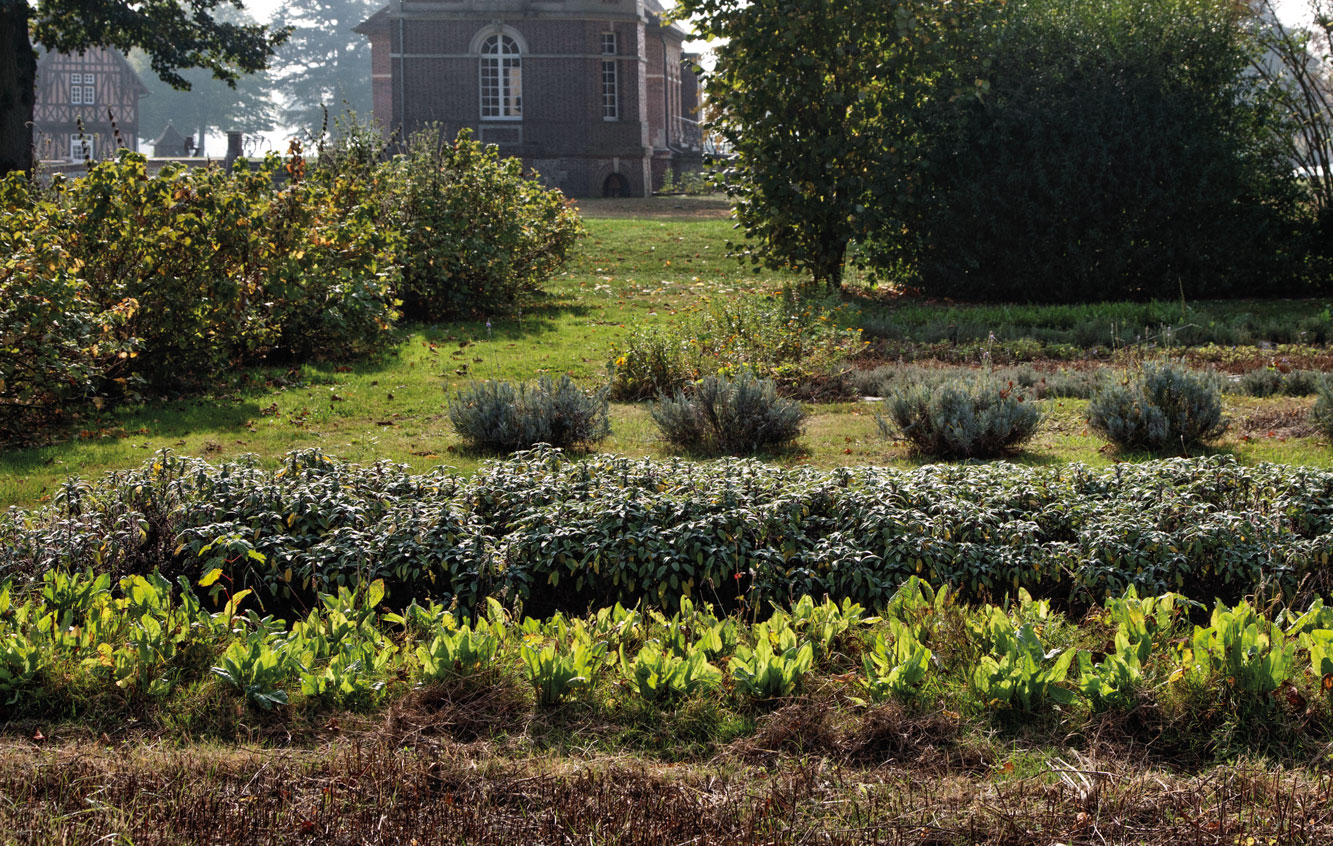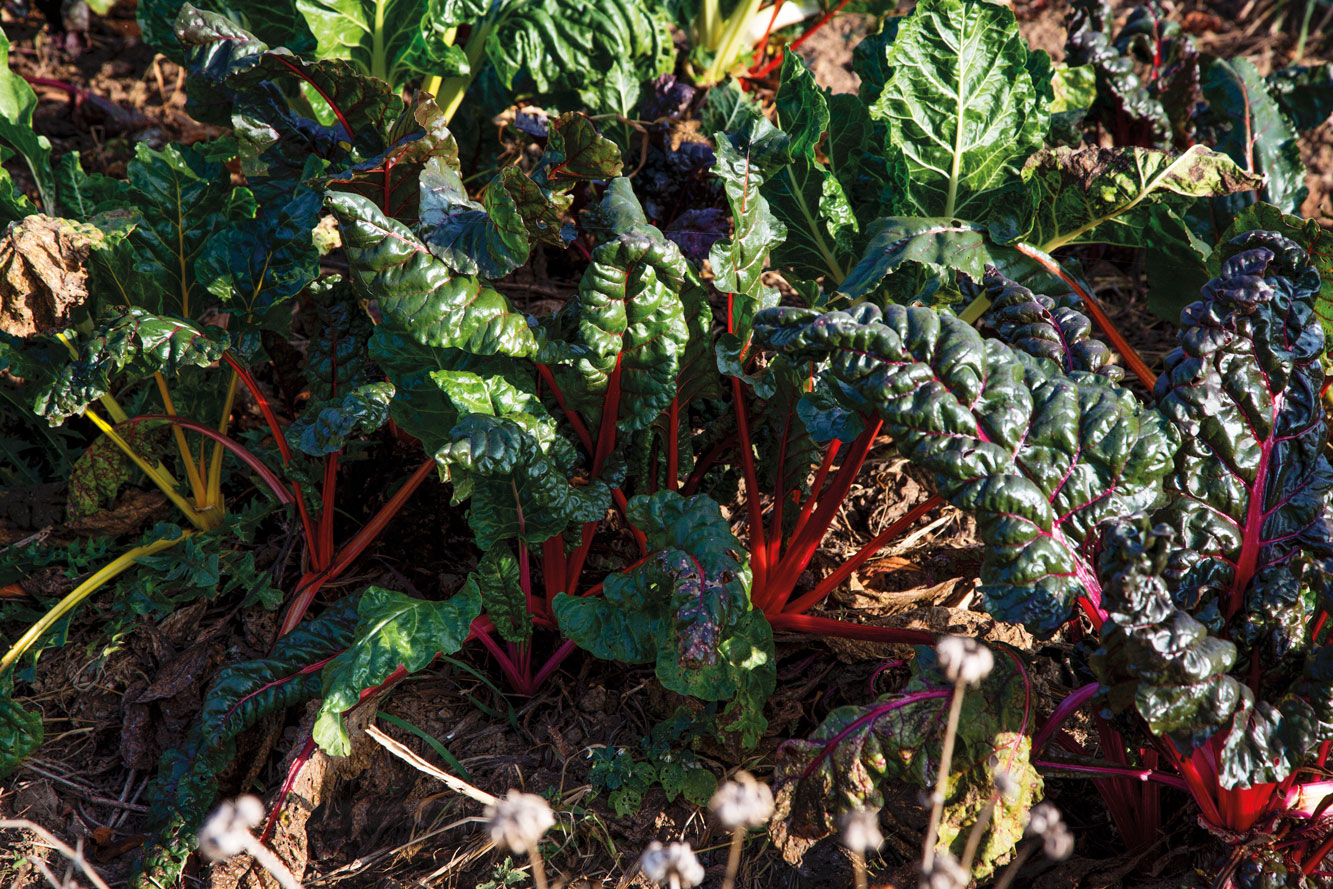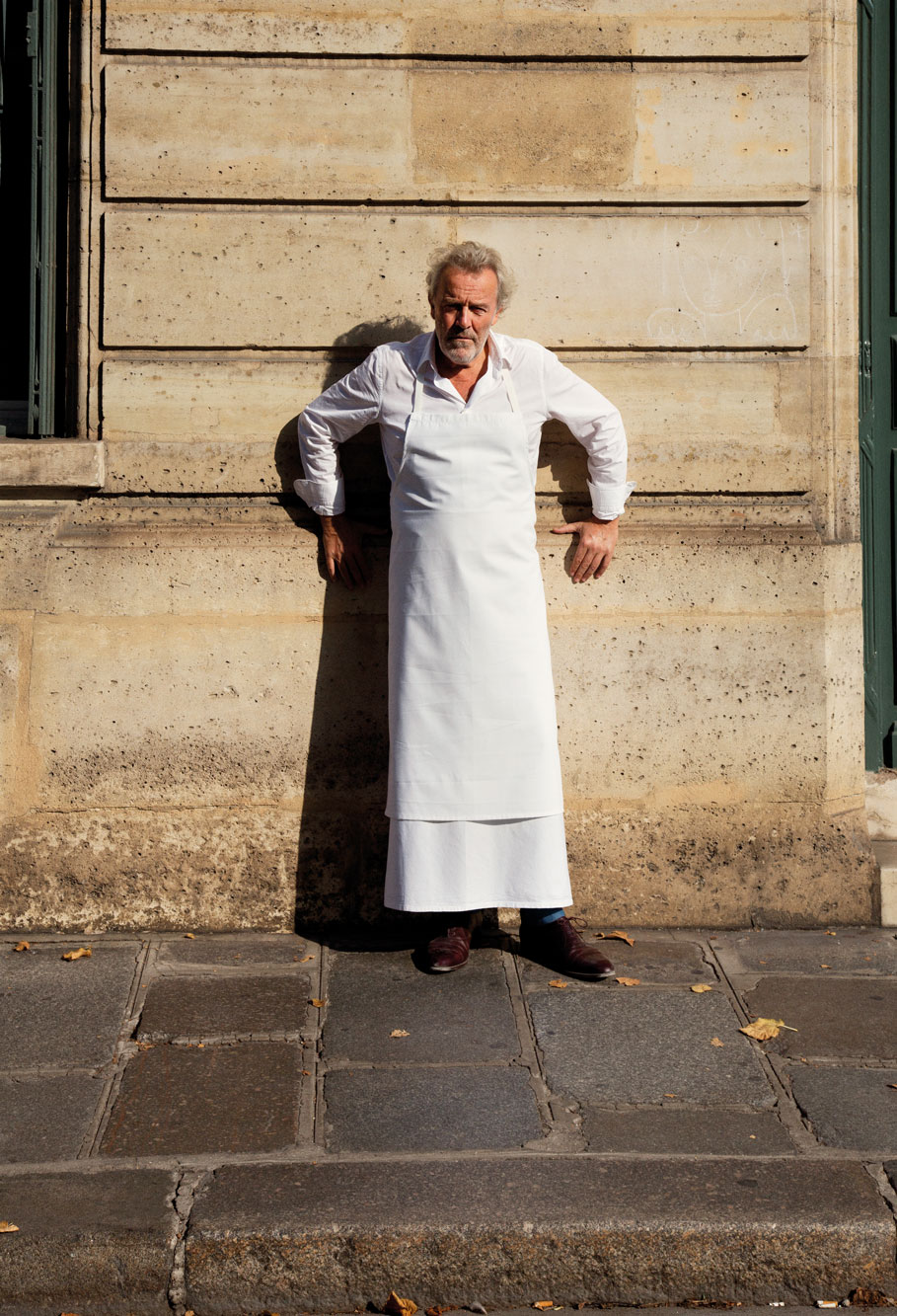Purple Magazine
— The Paris Issue #31 S/S 2019
l’arpège/alain passard
alain passard
interview by EMILIEN CRESPO
photography by CÉCILE BORTOLETTI
l’arpège, a three-michelin-star
restaurant since 1996,
brings fresh vegetables from
the chef’s farms to the table,
creating art every day
EMILIEN CRESPO — How did you learn to cook?
ALAIN PASSARD — My grandmother had a passion for cooking, a joie de vivre. She loved to host, and it’s with her that I did my first cooking and seasoning, when I was 12 or 13 years old. She had a wood-fired oven, and she taught me “the school of fire.” She cooked everything with wood. She would play with her senses. There’s no thermostat with wood! It’s all about hearing, seeing, touching. She gave me the power to tame and control the flame. That was my family education. And then, I was incredibly lucky to be accepted into the best establishment in Brittany at the time, Michel Kéréver’s Hostellerie du Lion d’Or near Rennes. I made a grand entrance. He was a great sauce maker, meat roaster… He really taught me everything I know. I stayed there for eight years.
EMILIEN CRESPO — Because it is so technical, does culinary training kill your creativity and imagination?
ALAIN PASSARD — It’s just like anything else — music, painting, sculpture, writing, dance. If you start cooking without a base, you can’t be creative with it. If you don’t know music theory, the fundamentals become impossible. You have to start by making the meals they teach you in school: sole meunière, cheese allumettes, puff pastry, Mornay sauce, blanquette of veal, bourguignon, lobster thermidor, rock lobster Bellevue — all the great classics! And only after that can you start to talk about imagination and creativity. You have to earn your stripes and learn the ropes first. It’s important to start by learning how to make a sauce that has a nice brilliance, a beautiful texture, and a seductive aroma. Then, through the aroma, you can learn how to correct a dressing, how to harmonize celeriac with pear! All in good time.
EMILIEN CRESPO — You have earned three Michelin stars since 1996. What does this mean to you? Is it still relevant?
ALAIN PASSARD — I am a pure product of Michelin. The guide has followed me around for a long time, and I received my first star in 1982. They discovered me through Gault & Millau. I have a lot of respect for them, and I know that they are in large part responsible for getting me to where I am now.
EMILIEN CRESPO — Does French gastronomy still mean something today?
ALAIN PASSARD — It will always exist because the foundation is local, and it involves real expertise: winegrowers, livestock farmers, fishermen, market gardeners. And the world will never be able to take that away from us. And on top of that, we have the French chef. So many foreign chefs want to train here with us! We have the best wines in the world. We have the best mushrooms, the best cheeses. People tell me this every day. In what country can you cook a carrot pulled right out of the soil that very morning, or a tomato picked from the branch in the morning and served at 1 PM on a plate? A tomato that hasn’t spent a minute in the fridge! French gastronomy will always exist. And you should see the generation that follows the 25-30 year-olds — they’re good!
EMILIEN CRESPO — Your restaurant was known as a meat restaurant, and in the early 2000s, you decided to devote yourself to vegetables. Why?
ALAIN PASSARD — It was actually a fabulous change! I really wish it on every cook in the world. It gives you a whole new energy, a joie de vivre. I worked with animal flesh for years, and one day I felt I’d arrived at the last page in the book. I was weary. I wanted to change careers. I wanted to use another material, the green material, which I had totally ignored for 30 years. And I wanted to work with the seasons. I’ve been passionate about color for a long time. I still ask myself how I could have ignored vegetables for so long. Today, I’ve put all my knowledge of cooking with meat in the service of vegetables.
EMILIEN CRESPO — Your salted, crusted beets, for instance!
ALAIN PASSARD — Onions flambé. Smoked celeriac. It’s fabulous. It’s an extraordinary difference. This happened during the Mad Cow outbreak. That wasn’t what changed things, though — I had already made up my mind. It’s very painful for a cook. I had a difficult emotional experience. We were working with complete confidence. We were convinced that everything happening in the kitchen at L’Arpège was high quality. And then one day, they told us, “We did everything we could to ward off Mad Cow at Rungis [the Paris region’s wholesale market], but we just don’t know for sure.” I got into this vegetable adventure so I wouldn’t get scalded a second time. I decided to buy three abandoned gardens and work with 12 gardeners.
EMILIEN CRESPO — And these three farms in the Eure, the Sarthe, and the Manche — they produce over 450 varieties of fruits and vegetables. All of this supplies the restaurant, but how do you make it economically viable?
ALAIN PASSARD — It’s priceless! We’re not about to start calculating. Even if it cost twice as much, I’d do it anyway! There’s so much confusion. You really ought to see what’s going on in the markets today. If you go to a market in the dead of winter, it’s like summer! Everything’s available for Christmas: strawberries, cherries, peaches, tomatoes, zucchini, eggplant, melons. It’s summer in the middle of winter! It’s very disturbing to find tomatoes, cucumbers, and melons in the middle of winter — they’re like water, they’re for hydrating in the summer when it’s hot. In January, when it’s cold, you need to warm up with celery soup, parsnip gratin, Jerusalem artichoke cream soup, pumpkin gnocchi. That’s all. I’m not making any of this up. Nature decreed it this way. I’m merely following what is natural.
EMILIEN CRESPO — Every morning, you receive these freshly harvested vegetables, and then you’re a bit like a jazz musician — you improvise melodies. What is your process of creation and improvisation?
ALAIN PASSARD — What you need to understand is that before the vegetables are even in your hand, when they’re still on the branch, the cooking is already done. Everything that ripens at the same time is connected. In the summer, a tomato, a zucchini, an eggplant, a pepper — all work perfectly well together. Then it’s up to you to find the tempo, but you can’t go wrong if you follow what’s in the garden basket. It’s the same in winter. Horseradish, salsify, celeriac, truffles — all of them work marvelously well. Now, if you add a tomato to this mix in the winter, you’re going to go off track. It will look, smell, and taste wrong. You won’t enjoy it. You’ll immediately feel that there is something wrong. The season is the base for the work. There are four seasons a year, and they are very precise — they will never change. Nature created them as they are, and they will stay as they are.
EMILIEN CRESPO — Let’s talk about the fundamentals of your cuisine: the school of fire, the school of gesture…
ALAIN PASSARD — The school of seasoning, too. All these different schools stand for a number. Five, for the five senses. Today, unfortunately, young chefs aren’t taught enough how to use their senses in culinary school. If nature created seasons, it’s so that we can avoid falling into a routine. I don’t have the same gestures in the spring as I do in the winter, and so on and so forth. That’s marvelous. The same goes for flavors, aromas, and visuals. Every three months, there is a new cooking notebook for the new season. This helps me to avoid falling into a routine. There are so many chefs who are weary of their work because they don’t follow the seasons. Because there is no sense of encounter in their lives as chefs anymore. A season is an encounter. A tomato is an encounter in July. An asparagus is an encounter in April. When you haven’t eaten a tomato for a year, it’s so enjoyable to taste one again! I work differently with a tomato and celery. The approach is different. No one talks about this, but that’s what is so fabulous. This needs to be taught in school!
EMILIEN CRESPO — The clientele at L’Arpège, at that beautiful restaurant, the many foreigners and public figures — how do you engage a young clientele today, one that has less access to such luxury?
ALAIN PASSARD — Our clientele is very young! L’Arpège is for the passionate, the curious. It’s obviously a significant sum of money, but they are ready to make a sacrifice to taste this cuisine. And for me, that is a real compliment. And for those who can’t afford it, we offer a basket of fresh produce for sale — so that at home, you can have the same quality vegetables that L’Arpège uses in the restaurant, and you can cook with recipes or videos. But we’re seeing a younger and younger clientele that sometimes comes just for a single dish. A nice assortment of morning garden vegetables, and that’s enough. You don’t need a big menu! With mini-pastries and petits fours, bread and butter, and a good green tea, you will have had a great experience for only 70 euros. It’s worth talking about this great experience. A beautiful vegetable dumpling can carry you over for the rest of the day.
EMILIEN CRESPO — Unlike the large majority of famous chefs, you have only one restaurant. Why is that?
ALAIN PASSARD — Because I like it here! Because I like my restaurant. Because I like my team. Because I like my clients. I like this place. I’ve had a very special life as a chef. Unique. A chef who’s in the middle of growing and has just received three stars, with a restaurant that’s working very well, and from one day to the next, decides to remove every dish on the menu that got him those three stars and move on to another cuisine: vegetables. That’s unheard of. When you have an adventure like this as a chef, you can’t be running around all over the place — you’ve got to be in the kitchen 24/7. All hands on deck, and you work! It’s not about being in Tokyo or New York or elsewhere. I’ve put all my energy into this restaurant. Into my kitchen. And still do today. There’s a sentence that makes my team laugh: “Vacations are made for those who work.” This is what I take pleasure in. At 14, I chose to become a chef, and I never turned back.
EMILIEN CRESPO — It really comes across that way.
ALAIN PASSARD — I also think I have to be present here to thank my customers. When a customer chooses to come here, I am very touched. And I like to tell them that. I like to be here for lunch and dinner to thank them for choosing L’Arpège. A client likes to know where the chef is. You have to keep up this idea that you are cooking, that you’ve got your hands in the pan. The great painters painted all day until the end of their lives. Rodin sculpted until the very end. And I’ve never tried to keep my assistants to myself. All my assistants now have their own restaurants. I inspired them to cook but also to start their own restaurants.
EMILIEN CRESPO — Are you optimistic about the future of cooking and of ingredients?
ALAIN PASSARD — As long as there is life, there is hope. You have to factor in climate change. Seasons will probably stay the same, with some discrepancies. We had a spring-like fall and an autumnal spring, which was almost very dramatic for us — the garden nearly rotted, the zucchinis were under water, but it worked out in the end. The positive thing is that people are celebrating. When I see the full terraces in Parisian restaurants at the end of October, I’m thrilled!
EMILIEN CRESPO — What does Paris mean to you?
ALAIN PASSARD — Paris enabled me to get to where I am today in every way. We have a great clientele because of Paris. It challenges us to push ourselves even further. I could have set up shop in Brittany, where I am from, but it would have been a much longer process, much more difficult. I owe everything to Paris. Paris is a place for creativity. You need only walk around. It’s a source of inspiration.
EMILIEN CRESPO — Louis XIV was the father of French gastronomy as we know it — namely, of the three-star system. What is this tradition of culinary arts? Should it be reinvented?
ALAIN PASSARD — It will make a comeback. We’re in the midst of coming back to some of these important bases. We will return to the way things were in the great establishments: Lasserre, Lapérouse, La Tour d’Argent, Maxim’s… It was a real spectacle! You would look around and see what was happening at the tables nearby: the preparation of a beautiful sole, the carving of a duck à l’orange, the preparation of veal kidneys flambé. I think people want to see real table service again, carving trolleys, carts of crudités, mobile kitchens, cheese gueridons. They want to see the cutting, the fruit basket with pineapple, apples, citrus fruits. And there’s no crockery anymore! I would like to see a beautiful hot crock with sauce steaming from it. Let’s stop all of this fussy cuisine, where all you do is add a little bit of spice. Let’s return to the truth, to taste, to flavor. You walk into a restaurant these days, and it doesn’t smell like anything! We need chefs to taste their own cuisine again. Ginger is great, but let’s go back to parsley.
EMILIEN CRESPO — Has Paris lost its culinary prestige?
ALAIN PASSARD — No! Young French cuisine is in great shape! We run the schools. There are so many great foreign chefs who have learned how to cook in Paris. We’ve had all these major French chefs — Michel Guérard, Alain Senderens, the Troisgros. The world has enjoyed our kitchens.
EMILIEN CRESPO — Do other cities inspire you?
ALAIN PASSARD — Prague and Rome are beautiful cities. It’s important to feed off others. But Paris is the capital of culture, and we must feed off it — eat well, go to exhibitions, listen to concerts, see plays, go to the Jardin des Plantes, the Serres d’Auteuil. The city is so culturally rich!
END
 AUGUSTE RODIN, THE THREE SHADES (LES TROIS OMBRES), 1886, RODIN MUSEUM, COPYRIGHT ADAGP, PARIS, 2019
AUGUSTE RODIN, THE THREE SHADES (LES TROIS OMBRES), 1886, RODIN MUSEUM, COPYRIGHT ADAGP, PARIS, 2019
 ALAIN PASSARD’S VEGETABLE GARDEN IN THE DOMAINE BOIS GIROULT, NORMANDY
ALAIN PASSARD’S VEGETABLE GARDEN IN THE DOMAINE BOIS GIROULT, NORMANDY
 ALAIN PASSARD’S VEGETABLE GARDEN IN THE DOMAINE BOIS GIROULT, NORMANDY
ALAIN PASSARD’S VEGETABLE GARDEN IN THE DOMAINE BOIS GIROULT, NORMANDY

















































































































































































































